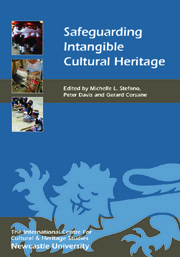Book contents
- Frontmatter
- Contents
- List of Illustrations
- Acknowledgments
- Touching the Intangible: An Introduction
- NEGOTIATING AND VALUING THE INTANGIBLE
- 1 The Paradoxes of Intangible Heritage
- 2 Memory, Museums and the Making of Meaning: A Caribbean Perspective
- 3 From Intangible Expression to Digital Cultural Heritage
- 4 Conversation Piece: Intangible Cultural Heritage in Sweden
- 5 Africa's Rich Intangible Heritage: Managing a Continent's Diverse Resources
- 6 The Silence of Meanings in Conventional Approaches to Cultural Heritage in Jordan: The Exclusion of Contexts and the Marginalisation of the Intangible
- 7 Conversation Piece: Intangible Cultural Heritage in India
- APPLYING THE INTANGIBLE CULTURAL HERITAGE CONCEPT
- ON THE GROUND: SAFEGUARDING THE INTANGIBLE
- List of Contributors
- Index
1 - The Paradoxes of Intangible Heritage
from NEGOTIATING AND VALUING THE INTANGIBLE
Published online by Cambridge University Press: 05 February 2013
- Frontmatter
- Contents
- List of Illustrations
- Acknowledgments
- Touching the Intangible: An Introduction
- NEGOTIATING AND VALUING THE INTANGIBLE
- 1 The Paradoxes of Intangible Heritage
- 2 Memory, Museums and the Making of Meaning: A Caribbean Perspective
- 3 From Intangible Expression to Digital Cultural Heritage
- 4 Conversation Piece: Intangible Cultural Heritage in Sweden
- 5 Africa's Rich Intangible Heritage: Managing a Continent's Diverse Resources
- 6 The Silence of Meanings in Conventional Approaches to Cultural Heritage in Jordan: The Exclusion of Contexts and the Marginalisation of the Intangible
- 7 Conversation Piece: Intangible Cultural Heritage in India
- APPLYING THE INTANGIBLE CULTURAL HERITAGE CONCEPT
- ON THE GROUND: SAFEGUARDING THE INTANGIBLE
- List of Contributors
- Index
Summary
There is little doubt that had it not been for the united nations education Scientific and Cultural Organisation (UNESCO) and its work in the field, the concept of intangible cultural heritage would not feature as prominently in the international heritage scene as it does today. Plans and programmes aimed at safeguarding and documenting the intangible heritage of local communities have been drawn from the South Pacific island nations of Tonga and Vanuatu to Cambodia, Siberia, Scotland and the Indigenous communities of Peru and Ecuador, to mention just a few (for more details, see www.unesco.org/culture/ich, accessed december 2009). This observation points, in my view, to two interesting phenomena: on the one hand, it reveals the global reach of the international organisation and its power to affect the lives of people living even in the most remote settings; on the other, it universalises and turns into practice a key anthropological idea: the belief that peoples around the world, despite of their cultural, religious and racial differences, share a common humanity expressed in embodied practices of intergenerational cultural transmission (see Levi-Strauss 1961; Ingold 1992).
UNESCO historiography suggests different paths through which intangible heritage came into being. Since the adoption of the World Heritage Convention in 1972, cultural heritage has been primarily conceptualised as monumental constructions, ruins, fenced-off archaeological sites and pristine landscapes. Such understandings pertain primarily to a european and north american preservationist ethos (Cleere 2001) and express Western-derived archaeological, art historical and naturalist narratives.
- Type
- Chapter
- Information
- Safeguarding Intangible Cultural Heritage , pp. 9 - 22Publisher: Boydell & BrewerPrint publication year: 2012



